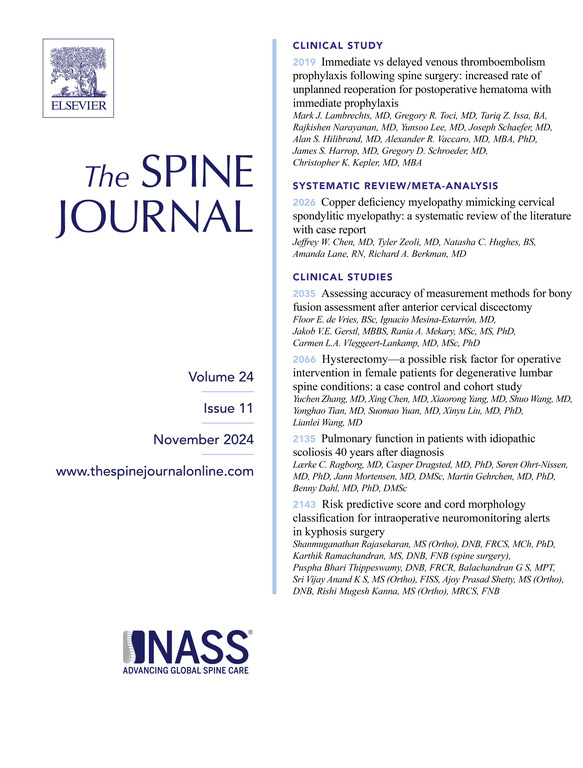脂质体布比卡因可减少脊柱手术的术后疼痛和阿片类药物用量:对 1269 名患者的 Meta 分析。
IF 4.9
1区 医学
Q1 CLINICAL NEUROLOGY
引用次数: 0
摘要
背景情况:脊柱手术的术后疼痛治疗仍然是一项挑战。脂质体布比卡因(LB)已成为阿片类镇痛的替代或辅助手段。目的:本荟萃分析旨在评估脊柱手术后使用 LB 后的疼痛结果、阿片类药物的使用情况以及 LOS。提取了有关医疗并发症、术后疼痛、术后阿片类药物用量和住院时间的数据。连续数据采用平均差(MD)和 95% CI,二分数据计算几率比(OR):这项荟萃分析包括 11 项研究,共涉及 1269 名患者(枸橼酸组 677 人,对照组 592 人)。在并发症发生率方面没有发现明显的统计学差异。LB组在术后第2天的疼痛评分明显降低(MD=-0.31;95% CI:-0.52--0.09,P=0.006),术后阿片类药物用量减少(MD=-0.42;95% CI:-0.79--0.06,P=0.02),住院时间缩短(MD=-0.57;95% CI:-0.94--0.20,P=0.002):结论:在脊柱手术后的术后初期,使用脂质体布比卡因可改善疼痛预后、减少阿片类药物的用量并缩短住院时间。尽管还有待进一步研究,但这些发现表明,脂质体布比卡因可能是脊柱手术患者疼痛治疗策略的重要辅助手段。本文章由计算机程序翻译,如有差异,请以英文原文为准。
Liposomal bupivacaine reduces postoperative pain and opioids consumption in spine surgery: a meta-analysis of 1,269 patients
BACKGROUND CONTEXT
Postoperative pain management in spine surgery remains a challenge. Liposomal bupivacaine (LB) has emerged as an alternative or adjunct to opioid-based analgesia. However, existing studies evaluating LB efficacy in spine surgery yield conflicting results and a meta-analysis compiling the literature is lacking.
PURPOSE
The purpose of this meta-analysis was to evaluate pain outcomes, opioid use, and LOS following LB administration after spine surgery.
STUDY DESIGN
Meta-analysis.
METHODS
Following the PRISMA guidelines, PubMed, Cochrane, and Google Scholar (pages 1–20) were accessed and explored up to May 2024. Data on medical complications, postoperative pain, postoperative opioid consumption, and length of stay were extracted. Mean differences (MD) with 95% CI were used for continuous data, and odds ratios (OR) were calculated for dichotomous data.
RESULTS
This meta-analysis comprised eleven studies consisting of 1,269 patients (677 in the LB group, 592 in the control group). No statistically significant difference was observed in complication rates. The LB group exhibited significantly lower pain scores at postoperative day 2 (MD=−0.31; 95% CI: −0.52 to −0.09, p=.006), lower postoperative opioid consumption (MD=−0.42; 95% CI: −0.79 to −0.06, p=.02), and shorter length of stay (MD=−0.57; 95% CI: −0.94 to −0.20, p=.002).
CONCLUSION
In the immediate postoperative period after spine surgery, the utilization of liposomal bupivacaine was associated with improved pain outcomes, decreased opioid consumption, and shortened length of stay. Although further research is warranted, these findings suggest that LB may offer a valuable adjunct to pain management strategies in patients undergoing spine surgery.
求助全文
通过发布文献求助,成功后即可免费获取论文全文。
去求助
来源期刊

Spine Journal
医学-临床神经学
CiteScore
8.20
自引率
6.70%
发文量
680
审稿时长
13.1 weeks
期刊介绍:
The Spine Journal, the official journal of the North American Spine Society, is an international and multidisciplinary journal that publishes original, peer-reviewed articles on research and treatment related to the spine and spine care, including basic science and clinical investigations. It is a condition of publication that manuscripts submitted to The Spine Journal have not been published, and will not be simultaneously submitted or published elsewhere. The Spine Journal also publishes major reviews of specific topics by acknowledged authorities, technical notes, teaching editorials, and other special features, Letters to the Editor-in-Chief are encouraged.
 求助内容:
求助内容: 应助结果提醒方式:
应助结果提醒方式:


